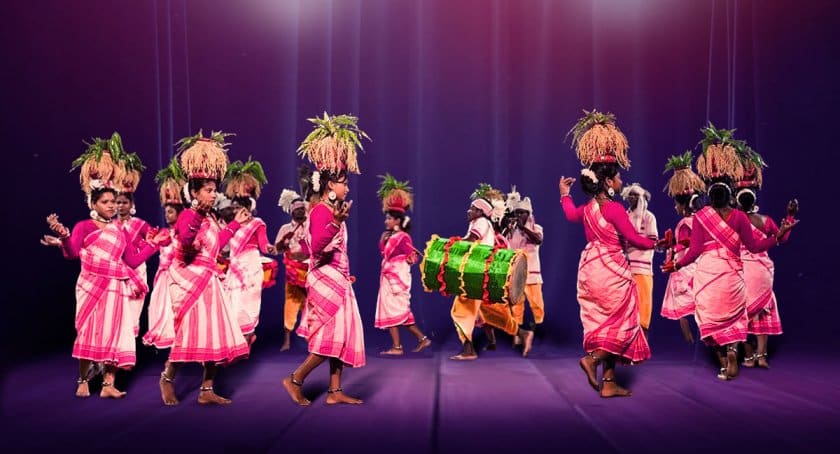Karma Folk Dance – Grace in Motion
Odisha, a land of rich cultural heritage and diverse traditions, is home to numerous folk dances that reflect its vibrant ethos. The Karma folk dance is among the most notable traditional dance forms, with a strong foundation in Indigenous cultures’ traditions and beliefs. Performed primarily by the Kudmi, Oraon, and Munda tribes, the Karma dance symbolizes prosperity, devotion, and joy. This blog examines the history, significance, performance, and cultural aspects of this enchanting folk dance of Odisha.
Origins and Historical Significance of Karma Dance
The Karma dance has ancient origins and is associated with the Karma festival, which celebrates nature and the changing seasons. The name “Karma” is derived from the Karam tree (Nauclea Parvifolia), which holds great religious and cultural importance among Odisha’s tribal communities. Historically, people performed this dance to please the gods for a good harvest, prosperity, and well-being. Over time, it has evolved into a popular cultural expression beyond religious boundaries.
Karma dance has its origins in oral traditions and tribal folklore. According to folklore, people first danced to honor the deities who govern nature and ensure bountiful crops. The Karma festival celebration deeply connects with agrarian life. It signifies the end of the monsoon season and the beginning of harvest. The dance expresses gratitude and serves as a communal activity that brings people together.
The Cultural and Spiritual Importance of Karma Dance
The Karma dance is an art form and a spiritual and social ritual. People perform it to invoke blessings for a bountiful harvest and overall prosperity. The dance profoundly connects to the following:
- Nature Worship: The dance pays homage to the Karam tree, believed to be sacred and associated with fertility and good fortune.
- Community Bonding: It fosters unity among tribal communities, strengthening social ties.
- Cultural Preservation: Dance helps pass down traditions, folklore, and historical values to younger generations.
- Festive Celebrations: Festive celebrations are a crucial element of the Karma festival, celebrated with grandeur and devotion.
The dance represents the inseparable bond between humans and nature, reinforcing the importance of environmental conservation. The symbolism of the Karam tree is profound, as it signifies growth, renewal, and protection.
When and Where is Karma Dance Performed?
People mainly perform the Karma dance during the Karma Festival, which falls in the Hindu month of Bhadra (August-September). The dance occurs in villages and open fields, where people gather in large numbers to participate in the festival. Apart from Odisha, the dance is also popular in Jharkhand, Chhattisgarh, Madhya Pradesh, and Bihar.
Elaborate rituals and joyous celebrations mark the festival. It begins with the sacred planting of the Karam tree branch. The villagers fast throughout the day and break their fast after dancing in the evening. Rhythmic music, traditional songs, and drumming accompany the entire event.
Rituals and Preparations for Karma Dance
The preparations for the Karma dance begin several days before the actual performance. Some crucial rituals include:
- Planting of the Karam Tree: As a symbol of commitment and respect, the community plants a Karam tree branch in the middle of the village.
- Fasting and Offerings: Devotees observe fasts and make offerings of grains, fruits, and flowers to the deity.
- Prayers and Songs: Traditional songs praise the Karam deity, accompanied by the rhythmic beats of drums and musical instruments.
The devotion and careful preparation highlight the dance’s deep-rooted cultural significance. The community expresses its faith and appreciation through coordinated motions and upbeat music, marking a moment of spiritual rejuvenation.
Unique Performance and Traditional Costumes of Karma Folk Dance
The Dance Movements:
The Karma dance is a highly energetic and rhythmic dance form. The key elements include:
- Circular Formations: Dancers move in graceful circular patterns, symbolizing the cycle of life and nature.
- Synchronized Steps: The men’s and women’s dancers’ synchronized motions produce a captivating visual impression.
- Use of Props: Some performances include bells, sticks, or branches of the Karam tree, adding an element of ritualistic significance.
The choreography of the dance is fluid, with participants swaying to the beats of traditional instruments. It is a visually captivating performance, reflecting the joy and devotion of the dancers.
The Music and Instruments:
Music plays a crucial part in enhancing the vibrancy of the Karma dance. Some of the commonly used musical instruments include:
- Mandar (a type of drum)
- Dhol (a sizeable traditional drum)
- Tasa (a percussion instrument)
- Cymbals and Flutes
The songs, sung in tribal dialects, narrate stories of love, devotion, nature, and mythology. The rhythmic beats and soulful melodies create an enchanting atmosphere, drawing participants and spectators into a celebratory mood.
The Attire:
The traditional attire of Karma dancers is colorful and vibrant, reflecting their cultural roots:
- Men’s Costume: Simple dhotis with vibrant turbans and accessories made from beads and shells.
- Women’s Costume: Bright sarees adorned with traditional jewelry and floral decorations.
The attire not only adds to the visual appeal but also signifies the tribal identity and heritage of the performers.
Regional Variations of Karma Dance
Though the essence of Karma dance remains the same, different regions have slight variations:
- Pauri Karma: The Pauri Bhuyan tribe performs Pauri Karma, which emphasizes quick motions.
- Munda Karma: The Munda tribe performs Munda Karma, which is well-known for its storytelling components.
- Oraon Karma: A highly ceremonial and spiritual approach that includes complex prayers.
These regional versions preserve the dance’s cultural relevance while showcasing its versatility.
Conclusion
Karma dance is a captivating representation of Odisha’s tribal culture, celebrating life, nature, and spirituality. Its rhythmic movements, soulful music, and deep-rooted traditions make it an integral part of India’s diverse folk heritage. While modernization presents challenges, conscious efforts from communities, artists, and cultural organizations ensure that this vibrant dance form thrives. By appreciating and promoting the Karma dance, we preserve the invaluable traditions that shape India’s cultural identity.


